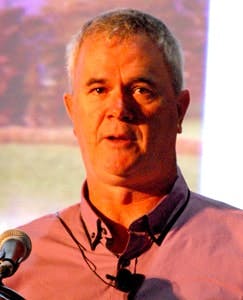Walt Boyes is the editor-in-chief for Control Global. He has more than 30 years of experience in sales, sales management, marketing, and product development in the automation industry both for sensors, devices and control systems for industrial and environmental controls, including Executive Committee and Board experience in several companies. Email him at [email protected] or check out his Google+ profile.
"This is the first time in 200 years that emerging market countries will contribute more economic growth than the developed ones," began Rockwell Automation's Kris Dornan as he kicked off the Food and Beverage Industry Forum at this week's Automation Fair in Houston. Food companies in particular face opportunities and daunting challenges as more and more of the world's still growing population emerge from poverty and swell the ranks of the middle class.
"Grain consumption has now exceeded production. The cost of fuel is variable and continues to rise," Dornan said. "Meanwhile, food manufacturers are challenged to improve asset utilization, drive speed and innovation, even as they manage risk."
Peter Williams, automation and process control manager for Fonterra Brands New Zealand Ltd., understands quite well the risks presented by aging systems. "We had a 10-year-old yogurt form filler with obsolete controls for which parts were impossible to get," Williams said. "We're in New Zealand. That's even worse."
The plant turned to Rockwell Automation to quickly retrofit the machine without compromising performance or flexibility, thus extending plant life and avoiding a $5 million capital expense. "We could replace the filler or replace the control system for much less," Williams said. "We chose to minimize the risk and replace the controls."
"We chose to minimize the risk and replace the controls." Fonterra Brands' Peter Williams discussed how it was able to quickly retrofit controls on an aging filler, avoiding downtime and a $5-million capital expense.
And when King's Hawaiian Bakery decided that the rising cost of fuel and transportation necessitated the building of an entirely new greenfield plant in Oakwood, Ga., the company bought specialized machines from eleven different OEMs. Each of those OEMs typically provides a system pre-configured and pre-wired with its own favorite control system. King's Hawaiian's director of engineering, Mike Williams, found the risk that one or more of the systems would be incompatible with others unacceptably high. "With more than 11 machines required for our production process, we couldn't just turn each OEM loose without clear specifications and an overall integrated design architecture," he said.
Bachelor Controls, a Rockwell Automation Solution Provider, was asked to provide overall project management services, because King's Hawaiian had already used Bachelor for projects in its main plant in Torrance, Calif. Williams believed that this would mitigate his project's risk of failure.
"Not only did we have to make sure that 11 OEMs would work together, but we also had to get the project done in 10 months. Plus, King's Hawaiian wanted remote monitoring to be an integral part of the project," said Kelli Uphaus, software engineer at Bachelor Controls.
"We started by writing detailed specifications for the systems that the OEMs were to provide, and then, after the OEMs' machines were all successfully started up, we designed and built the integration necessary to run the bakery to Mike Williams' satisfaction," Uphaus said.
When Italian palletizer company OCME needed to improve quality as well as reduce costs to remain competitive, it managed its risk and speeded up innovation by partnering with Rockwell Automation, according to Giacomo Gouery, chief operating officer of OCME America.
"EtherNet/IP is a global network we can use for effective control of the entire system, even remotely. Plus, it is easily programmed and tested with the RSLogix 5000 software," Gouery said. "The network allows all the PLCs to communicate with each other to synchronize the machines and to communicate product data for full traceability," Gouery said. "All the PLCs are connected to the customer network in order to supply all the production data needed to print out the labels that are applied to the pallets."
Dan Malyszko, director of operations (Denver) for Malisko Engineering, related his experience providing a yogurt production control system from scratch for Noosa Finest Yoghurt in Bellvue, Colo. "The existing yogurt production plant was an all-manual, labor-intensive operation that had reached its designed capacity," Malyszko said. "We had to automate a new facility with five-times greater capacity." The new system had to monitor the process, collect data, allow for easy future expansion — and be online in only six months. Further, Malyszko said, the Malisko team started in May 2012 with a process diagram that was a simple hand sketch. "Here, automate this," they were told.
By leveraging the power of PlantPAx, Malisko was able to produce a preliminary I/O and loop count. "Noosa needed reassurance up-front that the system would function reliably and efficiently. We were able to use the PlantPAx System Estimator within the Integrated Architecture Builder provided a baseline BOM [bill of material] and system performance summary to ensure a properly configured system."
In the end, construction was completed on time in October 2012, Malyszko said, and PlantPAx engineering tools allowed it to produce the system within the time frame Noosa needed. "The first batch of Noosa yogurt made on the new system was in spec, delicious and saleable!," Malyszko said. "With the new system, Noosa was able to grow 260% in 2012 and add 4,000 retailers nationwide."
About the Author
Walt Boyes
Editor in Chief

Leaders relevant to this article:



